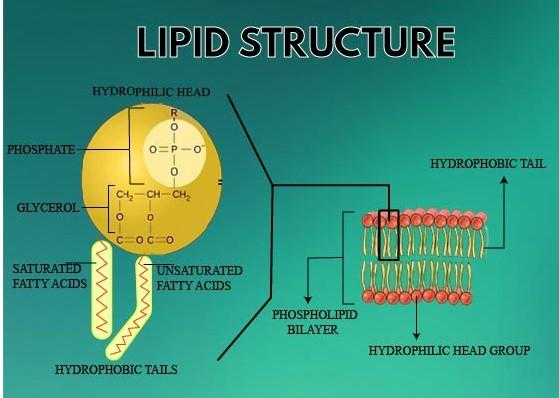
A lipid is a polymer made up of
(a) Modified glucose molecules
(b) Amino acids
(c) Nucleotides
(d) Fatty acids and glycerol
Answer
491.7k+ views
Hint: In humans and other animals lipids are the main constituents of body fat, as well as vegetable fat. The primary feature all lipid molecules share is they don't dissolve in water.
Complete answer:
A lipid is a polymer composed of three fatty acid molecules and one glycerol molecule. Lipids produce a special polymer form which is considered to be a key component of cell membranes and hormones. Lipids help to store energy, provide cushion, protect tissues, separate the body, and form membranes of cells.
- Glucose molecules are the monomers that constitute the polysaccharides.
- Amino acids are the polypeptide chain or protein monomer. 20 amino acids make up the various protein types.
- Nucleotides are the nucleic acid monomers e.g. DNA and RNA.
Fatty acids are lipid monomers formed by a hydrocarbon chain with a carboxyl group attached at the end. This is the simplest form of polymer in lipids. A carboxyl group consists of a carbon atom that forms a double bond with a single atom of oxygen and a single bond with an atom of oxygen bound to another atom of carbon. These chains make up the saturated and unsaturated fats in animals and plants.
Glycerol is a simple alcohol composed of three atoms of oxygen and three atoms of carbon that bind eight times with hydrogen atoms. When each single- bonded oxygen molecule binds to a carbon that is part of a glycerol molecule, fatty acids form more complex lipid polymers called triglycerides, triacylglycerols, or triacylglycerides. Triglycerides, especially make up animal products.

So, the correct answer is, ‘Fatty acids and glycerol’.
Note: Lipids are substances that are water- insoluble and can be categorized as fats, phospholipids, waxes, and steroids. This makes lipids essential to building structures, such as cell membranes, that have to retain their shape when surrounded by liquid. Its tight molecular bonds make lipids ideal for long-term storage of energy. The insolubility of lipid molecules is given because they form with ester bonds, compounds formed from an alcohol and acid by removing a hydrogen atom in a water molecule.
Complete answer:
A lipid is a polymer composed of three fatty acid molecules and one glycerol molecule. Lipids produce a special polymer form which is considered to be a key component of cell membranes and hormones. Lipids help to store energy, provide cushion, protect tissues, separate the body, and form membranes of cells.
- Glucose molecules are the monomers that constitute the polysaccharides.
- Amino acids are the polypeptide chain or protein monomer. 20 amino acids make up the various protein types.
- Nucleotides are the nucleic acid monomers e.g. DNA and RNA.
Fatty acids are lipid monomers formed by a hydrocarbon chain with a carboxyl group attached at the end. This is the simplest form of polymer in lipids. A carboxyl group consists of a carbon atom that forms a double bond with a single atom of oxygen and a single bond with an atom of oxygen bound to another atom of carbon. These chains make up the saturated and unsaturated fats in animals and plants.
Glycerol is a simple alcohol composed of three atoms of oxygen and three atoms of carbon that bind eight times with hydrogen atoms. When each single- bonded oxygen molecule binds to a carbon that is part of a glycerol molecule, fatty acids form more complex lipid polymers called triglycerides, triacylglycerols, or triacylglycerides. Triglycerides, especially make up animal products.

So, the correct answer is, ‘Fatty acids and glycerol’.
Note: Lipids are substances that are water- insoluble and can be categorized as fats, phospholipids, waxes, and steroids. This makes lipids essential to building structures, such as cell membranes, that have to retain their shape when surrounded by liquid. Its tight molecular bonds make lipids ideal for long-term storage of energy. The insolubility of lipid molecules is given because they form with ester bonds, compounds formed from an alcohol and acid by removing a hydrogen atom in a water molecule.
Recently Updated Pages
The correct geometry and hybridization for XeF4 are class 11 chemistry CBSE

Water softening by Clarks process uses ACalcium bicarbonate class 11 chemistry CBSE

With reference to graphite and diamond which of the class 11 chemistry CBSE

A certain household has consumed 250 units of energy class 11 physics CBSE

The lightest metal known is A beryllium B lithium C class 11 chemistry CBSE

What is the formula mass of the iodine molecule class 11 chemistry CBSE

Trending doubts
Is Cellular respiration an Oxidation or Reduction class 11 chemistry CBSE

In electron dot structure the valence shell electrons class 11 chemistry CBSE

What is the Pitti Island famous for ABird Sanctuary class 11 social science CBSE

State the laws of reflection of light

One Metric ton is equal to kg A 10000 B 1000 C 100 class 11 physics CBSE

Difference Between Prokaryotic Cells and Eukaryotic Cells




